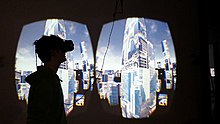User:Somiew/sandbox
Synchresis is the forged word of synchronism and synthesis which describes the audiovisual fusing-phenomenon that occurs when a sound is played with something visual, like a film. It's what makes post-synchronization of sounds such as voices and sound effects possible.[1]
Types[edit]

According to Ernest W. Adams, author and consultant on game design,[2] immersion can be separated into three main categories:
- Tactical immersion
- Tactical immersion is experienced when performing tactile operations that involve skill. Players feel "in the zone" while perfecting actions that result in success.
- Strategic immersion
- Strategic immersion is more cerebral, and is associated with mental challenge. Chess players experience strategic immersion when choosing a correct solution among a broad array of possibilities.
- Narrative immersion
- Narrative immersion occurs when players become invested in a story, and is similar to what is experienced while reading a book or watching a movie.
Staffan Björk and Jussi Holopainen, in Patterns In Game Design,[3] divide immersion into similar categories, but call them sensory-motoric immersion, cognitive immersion and emotional immersion, respectively. In addition to these, they add a new category:
- Spatial immersion
- Spatial immersion occurs when a player feels the simulated world is perceptually convincing. The player feels that he or she is really "there" and that a simulated world looks and feels "real".
Presence[edit]

Presence, a term derived from the shortening of the original "telepresence", is a phenomenon enabling people to interact with and feel connected to the world outside their physical bodies via technology. It is defined as a person's subjective sensation of being there in a scene depicted by a medium, usually virtual in nature.[5] Most designers focus on the technology used to create a high-fidelity virtual environment; however, the human factors involved in achieving a state of presence must be taken into account as well. It is the subjective perception, although generated by and/or filtered through human-made technology, that ultimately determines the successful attainment of presence.[6]
Virtual reality glasses can produce a visceral feeling of being in a simulated world, a form of spatial immersion called Presence. According to Oculus VR, the technology requirements to achieve this visceral reaction are low-latency and precise tracking of movements.[7][8][9]
Michael Abrash gave a talk on VR at Steam Dev Days in 2014.[10] According to the VR research team at Valve, all of the following are needed to establish presence.
- A wide field of view (80 degrees or better)
- Adequate resolution (1080p or better)
- Low pixel persistence (3 ms or less)
- A high enough refresh rate (>60 Hz, 95 Hz is enough but less may be adequate)
- Global display where all pixels are illuminated simultaneously (rolling display may work with eye tracking.)
- Optics (at most two lenses per eye with trade-offs, ideal optics not practical using current technology)
- Optical calibration
- Rock-solid tracking – translation with millimeter accuracy or better, orientation with quarter degree accuracy or better, and volume of 1.5 meter or more on a side
- Low latency (20 ms motion to last photon, 25 ms may be good enough)
- ^ 1947-, Chion, Michel, (1994). Audio-vision : sound on screen. Gorbman, Claudia., Murch, Walter, 1943-. New York: Columbia University Press. ISBN 9780231078986. OCLC 28257146.
{{cite book}}:|last=has numeric name (help)CS1 maint: extra punctuation (link) CS1 maint: multiple names: authors list (link) - ^ Adams, Ernest (July 9, 2004). "Postmodernism and the Three Types of Immersion". Gamasutra. Retrieved 2007-12-26.
- ^ Björk, Staffan; Jussi Holopainen (2004). Patterns In Game Design. Charles River Media. p. 206. ISBN 1-58450-354-8.
- ^ "10.000 moving cities - same but different, interactive net-and-telepresence-based installation 2015". Marc Lee. Retrieved 2017-03-12.
- ^ Barfield, Woodrow; Zeltzer, David; Sheridan, Thomas; Slater, Mel (1995). "Presence and Performance Within Virtual Environments". In Barfield, Woodrow; Furness, III, Thomas A. (eds.). Virtual Environments and Advanced Interface Design. Oxford University Press. p. 473. ISBN 0195075552.
- ^ Thornson, Carol; Goldiez, Brian (January 2009). "Predicting presence: Constructing the Tendency toward Presence Inventory". International Journal of Human Computer Studies. 67 (1): 62–78. doi:10.1016/j.ijhcs.2008.08.006. Retrieved 19 June 2017.
- ^ Seth Rosenblatt (19 March 2014). "Oculus Rift Dev Kit 2 now on sale for $350". CNET. CBS Interactive.
- ^ "Oculus Rift DK2 hands-on and first-impressions". SlashGear.
- ^ Announcing the Oculus Rift Development Kit 2 (DK2)
- ^ Abrash M. (2014). What VR could, should, and almost certainly will be within two years
